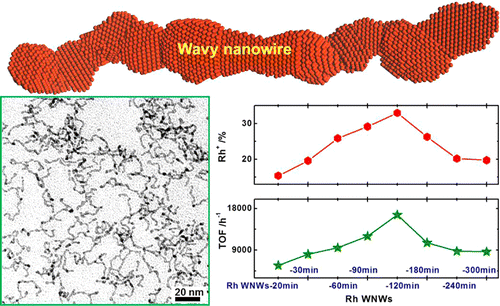Publications
High Density Catalytic Hot Spots in Ultrafine Wavy Nanowires
X. Huang, Z. Zhao, Y. Chen, C.-Y. Chiu, L. Ruan, Y. Liu, M. Li, X. Duan, and Y. Huang
Nano Lett. 14, 3887-3894 (2014)

Structural defects/grain boundaries in metallic materials can exhibit unusual chemical reactivity and play important roles in catalysis. Bulk polycrystalline materials possess many structural defects, which is, however, usually inaccessible to solution reactants and hardly useful for practical catalytic reactions. Typical metallic nanocrystals usually exhibit well-defined crystalline structure with few defects/grain boundaries. Here, we report the design of ultrafine wavy nanowires (WNWs) with a high density of accessible structural defects/grain boundaries as highly active catalytic hot spots. We show that rhodium WNWs can be readily synthesized with controllable number of structural defects and demonstrate the number of structural defects can fundamentally determine their catalytic activity in selective oxidation of benzyl alcohol by O2, with the catalytic activity increasing with the number of structural defects. X-ray photoelectron spectroscopy (XPS) and cyclic voltammograms (CVs) studies demonstrate that the structural defects can significantly alter the chemical state of the Rh WNWs to modulate their catalytic activity. Lastly, our systematic studies further demonstrate that the concept of defect engineering in WNWs for improved catalytic performance is general and can be readily extended to other similar systems, including palladium and iridium WNWs.
UCLA, Department of Chemistry and Biochemistry
607 Charles E. Young Drive East, Box 951569
Los Angeles, CA 90095-1569
E-mail: xduan@chem.ucla.edu
607 Charles E. Young Drive East, Box 951569
Los Angeles, CA 90095-1569
E-mail: xduan@chem.ucla.edu







